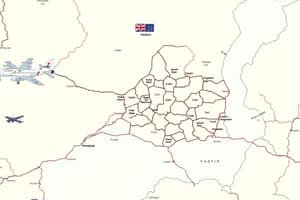Podcast
Questions and Answers
What is one of the inputs for issuing a warning order?
What is one of the inputs for issuing a warning order?
- Public affairs announcements
- Detailed mission report
- Commander’s intent and guidance (correct)
- Subordinate unit reports
Initial Mission Statements are developed during the course of action development phase.
Initial Mission Statements are developed during the course of action development phase.
False (B)
What does OPSEC stand for in military planning?
What does OPSEC stand for in military planning?
Operations Security
The _____ prepares input to the warning order including early tasking to subordinate units.
The _____ prepares input to the warning order including early tasking to subordinate units.
Match the following elements of military planning with their definitions:
Match the following elements of military planning with their definitions:
Which of the following is NOT a part of the inputs for a warning order?
Which of the following is NOT a part of the inputs for a warning order?
Military deception guidance is included in the warning order inputs.
Military deception guidance is included in the warning order inputs.
What is the role of the G-2 in the mission analysis process?
What is the role of the G-2 in the mission analysis process?
What is the primary purpose of COA analysis and war-gaming?
What is the primary purpose of COA analysis and war-gaming?
War-gaming processes do not contribute to identifying new hazards.
War-gaming processes do not contribute to identifying new hazards.
What are the two main inputs needed for developing COA statements?
What are the two main inputs needed for developing COA statements?
During COA development, the IO officer prepares a scheme statement and ______ for each COA.
During COA development, the IO officer prepares a scheme statement and ______ for each COA.
Which of the following is NOT an output of COA development?
Which of the following is NOT an output of COA development?
The IO officer's role during war-gaming is to diminish the integration of information operations.
The IO officer's role during war-gaming is to diminish the integration of information operations.
Define the term 'HPT' in the context of COA development.
Define the term 'HPT' in the context of COA development.
Match the terms with their correct definitions:
Match the terms with their correct definitions:
What must the IO officer establish to measure the effectiveness of IRC tasks?
What must the IO officer establish to measure the effectiveness of IRC tasks?
The COA statement and supporting sketch prepared by the G-3 (S-3) must include who, what, when, where, how, and why.
The COA statement and supporting sketch prepared by the G-3 (S-3) must include who, what, when, where, how, and why.
What happens if an IO task's results cannot be measured?
What happens if an IO task's results cannot be measured?
The IO officer submits IRs for the COA that the commander approves to the _____ (G-2/S-2).
The IO officer submits IRs for the COA that the commander approves to the _____ (G-2/S-2).
Match the responsibilities with the correct officer or group:
Match the responsibilities with the correct officer or group:
Which of the following factors influence the assignment of headquarters for IO-dominant missions?
Which of the following factors influence the assignment of headquarters for IO-dominant missions?
Commanders should exclude the IO officer from MDMP briefings to allow for a more streamlined discussion.
Commanders should exclude the IO officer from MDMP briefings to allow for a more streamlined discussion.
When determining a COA, the commander may select a given COA, modify it, or create a _____ altogether.
When determining a COA, the commander may select a given COA, modify it, or create a _____ altogether.
Flashcards
Mission Analysis
Mission Analysis
The process of understanding the mission and how to achieve it based on the commander's intent and guidance.
Warning Order
Warning Order
A document created by the commander that outlines the mission, intent, initial objectives, and guidance for the operation.
Mission Analysis Inputs
Mission Analysis Inputs
A collection of information, data, and analysis used to develop a Course of Action (COA). It includes inputs such as the commander's intent and guidance, mission analysis products, and intelligence.
Operations Order (OPORD)
Operations Order (OPORD)
Signup and view all the flashcards
Course of Action (COA)
Course of Action (COA)
Signup and view all the flashcards
Intelligence Preparation of the Battlefield (IPB)
Intelligence Preparation of the Battlefield (IPB)
Signup and view all the flashcards
Essential Elements of Friendly Information (EEFI)
Essential Elements of Friendly Information (EEFI)
Signup and view all the flashcards
Course of Action Development
Course of Action Development
Signup and view all the flashcards
COA Analysis (War-gaming)
COA Analysis (War-gaming)
Signup and view all the flashcards
What is the purpose of COA analysis?
What is the purpose of COA analysis?
Signup and view all the flashcards
What is the goal of war-gaming?
What is the goal of war-gaming?
Signup and view all the flashcards
What is COA analysis?
What is COA analysis?
Signup and view all the flashcards
How does war-gaming help synchronize IO operations?
How does war-gaming help synchronize IO operations?
Signup and view all the flashcards
Why are OPSEC measures important in war-gaming?
Why are OPSEC measures important in war-gaming?
Signup and view all the flashcards
What is involved in COA analysis?
What is involved in COA analysis?
Signup and view all the flashcards
What is war-gaming and why is it important?
What is war-gaming and why is it important?
Signup and view all the flashcards
What are information requirements (IRs)?
What are information requirements (IRs)?
Signup and view all the flashcards
Who submits information requirements (IRs)?
Who submits information requirements (IRs)?
Signup and view all the flashcards
How are IO tasks evaluated?
How are IO tasks evaluated?
Signup and view all the flashcards
What factors determine a headquarters' effectiveness in IO?
What factors determine a headquarters' effectiveness in IO?
Signup and view all the flashcards
Why do commanders consult the IO officer for IO-dominant operations?
Why do commanders consult the IO officer for IO-dominant operations?
Signup and view all the flashcards
Who prepares the COA statements and sketches?
Who prepares the COA statements and sketches?
Signup and view all the flashcards
What does the IO officer contribute to COA statements?
What does the IO officer contribute to COA statements?
Signup and view all the flashcards
Why is the IO officer present at MDMP briefings?
Why is the IO officer present at MDMP briefings?
Signup and view all the flashcards
Study Notes
Planning
- Planning is the art and science of understanding a situation, envisioning a desired future, and laying out effective ways to achieve that future.
- Planning helps commanders create a common vision between commanders, staffs, subordinate commanders, and unified action partners.
- Planning results in a plan and orders that synchronize the actions of forces in time, space, and purpose to achieve objectives.
- Commanders and staffs integrate information operations (IO) into the plan from the beginning.
- The IO officer focuses on IO planning, but the entire staff contributes.
- Planning activities range from conceptual to detailed planning.
- Conceptual planning involves understanding the environment, determining the end state, and visualizing a general approach.
- Detailed planning turns the general approach into a complete, practical plan.
- Army design methodology (ADM) assists with conceptual planning, focusing on understanding, visualizing, and describing operations.
- The military decision-making process (MDMP) translates a commander's vision into an operations plan.
- Both the problem to be solved and the approach have significant information-related aspects.
Information Operations and Army Design Methodology
- Army Design Methodology (ADM) applies critical and creative thinking to unfamiliar problems.
- ADM helps commanders and staffs think deeply about the situation.
- ADM supports organizational learning through reframing to improve understanding of problems.
- Human-centered issues are driven by human decision-making.
- Framing the current state and desired future state of the information environment are key to framing an operational environment and developing an operational approach.
Information Operations and the Military Decision-Making Process (MDMP)
- Commanders use the MDMP to understand the situation and mission, make informed decisions, and create an operations plan or order.
- IO planning is integral to MDMP, encompassing intelligence preparation of the battlefield (IPB) and targeting processes.
- The G-2 (S-2) and fire support representatives participate in IO working groups.
- The IO officer ensures IO coordination with the overall operation.
- The scheme of IO clearly defines how commanders intend to employ and synchronize information-related capabilities.
IO Objectives
- IO objectives express specific and measurable outcomes and their timing, achievable, relevant, and time-bounded (SMART).
- IO objectives align with tactical and strategic theater goals.
- Accurate situational understanding is essential for establishing IO objectives.
Tasks
- Tasks support the achievement of IO objectives, developed specifically for a particular information-related capability (IRC).
- Tasks are initially discussed in general terms, then assigned later.
Flexibility and Lead Times
- IO planning requires adaptability and flexibility.
- Some information-related capabilities (IRCs) require substantial lead time for planning.
- Coordination across multiple lines of effort is essential.
- Intelligence is a factor in planning.
- Execution and assessment can have a time lag.
Receipt of Mission
- Receiving a mission involves initial assessment.
- A warning order (WARNORD) is prepared based on the assessment.
- Participation in initial assessments, reviewing running estimates, providing input to initial guidance, and preparing for further planning are crucial.
Running Estimate
- A running estimate is a continuous assessment of the current situation during IO planning.
- The running estimate aids in determining if operations are consistent with the commander's intent.
- The running estimate assists with the MDMP steps, facilitates communication, and provides a basis for recommendations.
Mission Analysis
- Mission analysis focuses on understanding the situation, determining the operation's purpose, and identifying information-related resources.
- The staff analyzes higher headquarters' plans and orders for relevant IO aspects.
- Higher headquarters' area of operations, available assets, missions of neighboring divisions, and planning schedules are identified.
- Planning that neglects these factors weakens operational coherence.
- The process of Initial Intelligence Preparation of the Battlefield (IPB) focuses on defining the area of operations, understanding the threat, specifying threat courses of action, and identifying threat capabilities and vulnerabilities.
- Conducting mission analysis involves defining the information environment by considering how military operations and threat capabilities affect it.
- Conducting mission analysis necessitates developing information overlays, diagrams, or other visual aids illustrating threat and friendly information elements.
Beginning Risk Management
- Commanders and staffs assess and monitor risks associated with IO throughout the operations process.
- IO-associated hazards fall broadly into three categories: OPSEC vulnerabilities, mission-command vulnerabilities, and IO tasks.
- IO assessments integrate into overall operations and staff planning efforts.
Develop Commander's Critical Information Requirements
- A commander's critical information requirement (CCIR) is a critical information element needed for timely decision-making.
- IO staff sections, including the IO officer, recommend CCIRs to the G-3 (S-3), who presents these to the commander for approval.
- Requirements vary according to the stage of operations, and information that impacts decision-making changes as an operation progresses.
Develop the Initial Information Collection Plan
- The staff identifies and prioritizes information gaps needed to support IO planning, execution, and assessment.
- Priority is established for information collection efforts answering specific critical information requirements (CCIRs).
- The initial information collection plan outlines the information demands to satisfy these demands.
Update Plan for the Use of Available Time
- The IO officer ensures a consistent plan from the moment of initial mission briefing to the operation's execution.
- The timelines for the planned operations align with the command and threat timelines to maximize efficiency.
Develop Initial themes and messages
- To ensure operational success, commanders should identify and engage critical actors and organizations.
- Public affairs officers (PAO) and Military Information Support Operations (MISO) personnel lead the theme and message development process.
- Higher headquarters, the Department of State, or geographic combatant commands specify the appropriate themes and messages based on the context of the operation and target audience.
Develop a Proposed Problem Statement
- A problem statement clearly articulates the discrepancy between the current situation and the desired end state, which drives the development of concrete solutions.
Develop a Proposed Mission Statement
- The mission statement outlines the purpose of the operation, addressing essential tasks supported by the IO officer's assessments.
Presenting Mission Analysis Briefing
- Present the results of mission analysis to the commander, to develop a shared understanding of the operation's variables and power elements.
Develop and Issue Initial Commander's Intent
- The commander's intent clarifies the purpose of the operation, the end state desired, and how to approach its achievement, clearly defining the overarching operation's goals.
- The IO officer develops recommended input to the commander's intent.
Develop and Issue Initial Planning Guidance
- Guidance is articulated to focus the staff's planning on aspects of the mission where IO is likely to increase effectiveness or be dominant.
- IO decision-making authority is specified to provide necessary oversight and control during operations.
Begin Risk Management
- IO risk assessment is integrated into the overall process and staff sections provide input.
- Hazards are categorized to aid in focused planning.
Course of Action Evaluation Criteria
- Course of action (COA) evaluation criteria are used to measure relative effectiveness of the different courses of action, aiding in objective selection.
- The criteria aid in understanding the relative strengths and weaknesses of potentially different courses of action.
Issue Warning Order
- A warning order (WARNORD) encompasses the essential IO tasks, emphasizing changes to task organization and IO considerations in relevant paragraphs.
Course of Action Development
- The staff develops courses of action (COAs) that integrate combat power elements to meet the mission.
Assess Relative Combat Power
- Commanders utilize relative combat power analysis to evaluate the synergistic impact of IO on friendly forces.
Generate Options
- The IO officer assists the staff in exploring various ways IO can support each course of action (COA), considering necessary resources and trade-offs.
Array Forces
- The IO officer, alongside other staff members, aligns forces to identify resources and make informed decisions regarding force configuration, addressing the factors that influence the decision process.
Develop a Broad Concept
- IO initiatives are articulated in terms of objectives and specific actions, providing a framework for execution consistent with commander’s intent.
- IO objectives should support the commander's overall concept of operations and provide specific guidance.
Courses of Action Approval
- After reviewing and comparing COAs, commanders choose the most effective one and articulate their intent.
Orders Production, Dissemination, and Transition
- The IO Officer ensures input into the orders aligns with the approved COA.
- Coordination to ensure that IO is fully integrated into the operational plans.
Studying That Suits You
Use AI to generate personalized quizzes and flashcards to suit your learning preferences.



